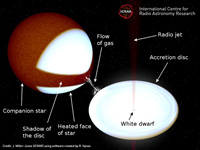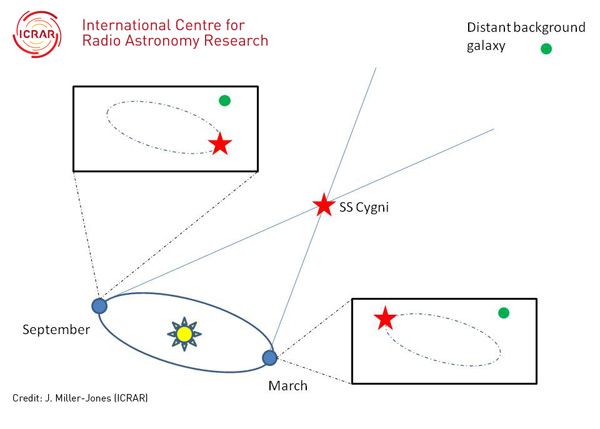- Home
- Project Overview
- Activities
- Contact Us
- Documents
- Management
- Objectives
- Partners
- What is e-VLBI?
- Project Updates
- Meetings & Events
- Papers
- Posters
- Presentations
- Press Releases
- Project Resources
- NEXPReS Wiki
- EVN e-VLBI pages
- EXPReS
Triggered e-EVN observations help pinpoint puzzling white dwarf
Thu, 23/05/2013 - 16:32
Above: Schematic diagram of the white dwarf binary system SS Cygni. Image credit: J. Miller-Jones (ICRAR), using software created by R. Hynes. For full resolution images, description and animation: http://www.icrar.org/sscygni.DWINGELOO, The Netherlands (24 May 2013) - The "triggered e-VLBI" capability of the European VLBI Network has aided an extremely precise measurement of the distance to a star system. This has allowed astronomers to finally solve a decade-old puzzle, confirming our understanding of the way exotic objects like black holes swallow the material they rip off the surface of nearby binary companion stars.
Published today in the journal Science, a team of astronomers headed by Dr James Miller-Jones from the International Centre for Radio Astronomy Research (ICRAR) in Australia have measured the distance to star system SS Cygni to be 372 light years, much closer than a previous measurement made by the Hubble Space Telescope in the 1990s.
The measurement was initiated when amateur optical astronomers detected changes in the compact star system. This alerted Miller-Jones's team to conduct observations with two of the world’s most accurate radio telescope arrays: the European VLBI Network (EVN), using telescopes in Europe and South Africa, and the Very Long Baseline Array (VLBA) in the United States.
Very Long Baseline Interferometry (VLBI) observations by the EVN typically require significant advanced coordination among the institutes that operate the various telescopes, but special procedures have been put in place for organizing so-called "triggered" observations on very short notice.
"This is fantastic use of triggered e-VLBI. The EVN implemented this special mode for just this type of science, which requires both utmost precision and flexibility," said Zsolt Paragi, Senior Support Scientist at the Joint Institute for VLBI in Europe (JIVE). JIVE operates the data correlator for the EVN and provides support services to the EVN and its users.
Dr Miller-Jones’ team used the VLBI observations to measure the annual wobble of the system compared to distant background galaxies, allowing them to measure the distance to SS Cygni with unprecedented precision
“If you hold your finger out at arm’s length and move your head from side to side, you should see your finger appear to wobble against the background. If you move your finger closer to your head, you’ll see it starts to wobble more. We did the exact same thing with SS Cygni - we measured how far it moved against some very distant galaxies as the Earth moved around the Sun,” Dr James Miller-Jones said.
“The wobble we were detecting is the equivalent of trying to see someone stand up in New York from as far as away as Sydney.”
Above: Measuring the distance to SS Cygni using the parallax technique.
As the Earth orbits the Sun, SS Cygni appears to move back and forth
relative to the position of a distant background galaxy, which is so far
away that it stays stationary on the sky. The size of the apparent
“wobble” of SS Cygni gives a direct measure of the distance; the further
away SS Cygni is from Earth, the smaller the wobble. Image credit: J.
Miller-Jones (ICRAR)
|

